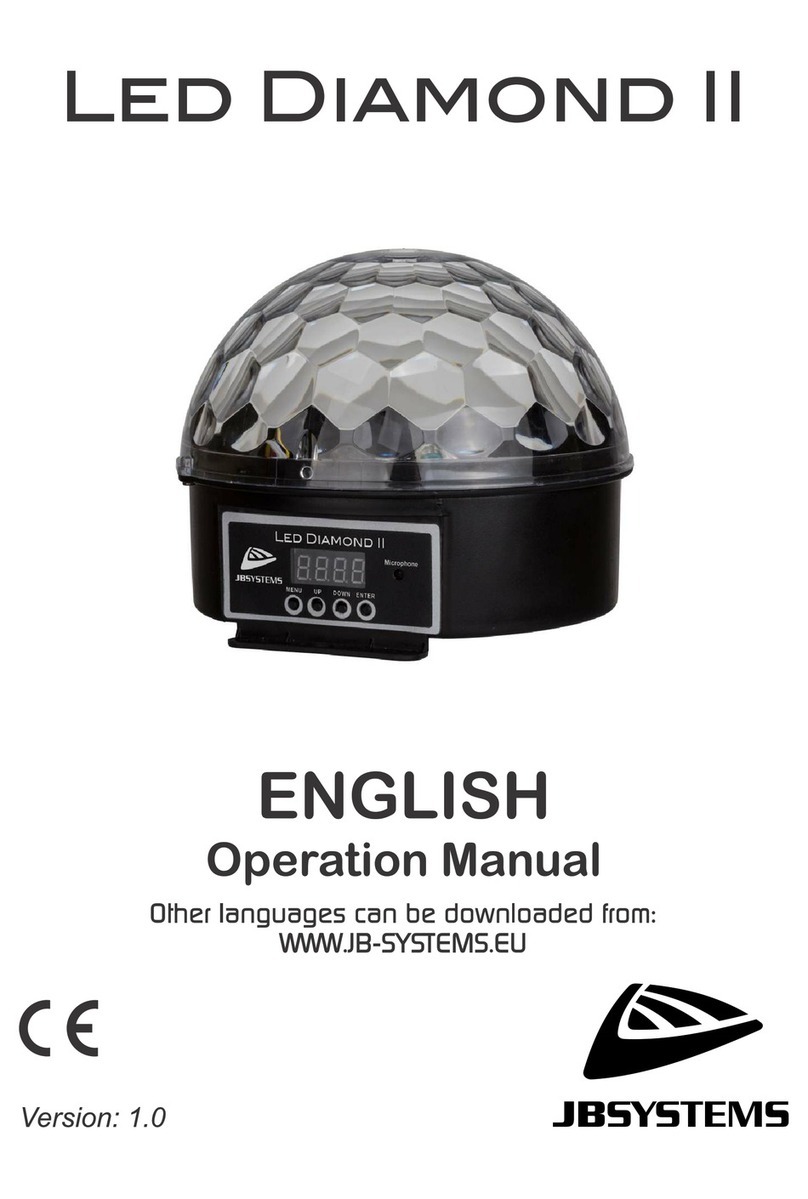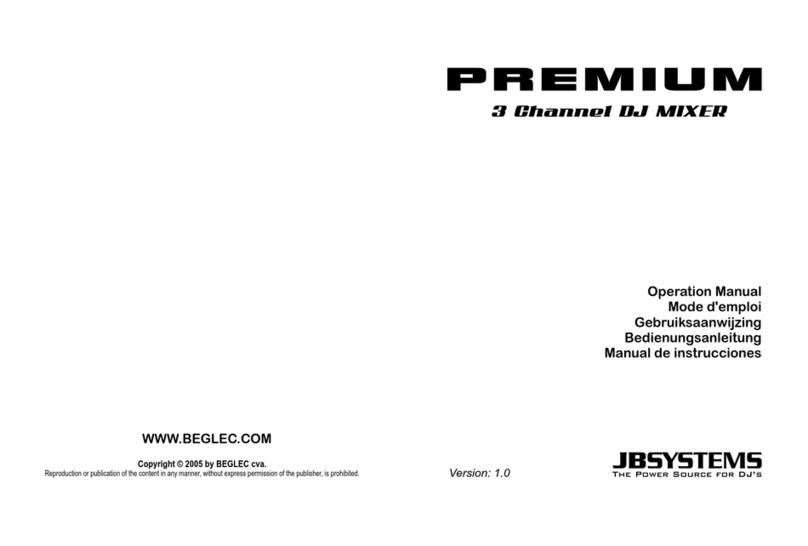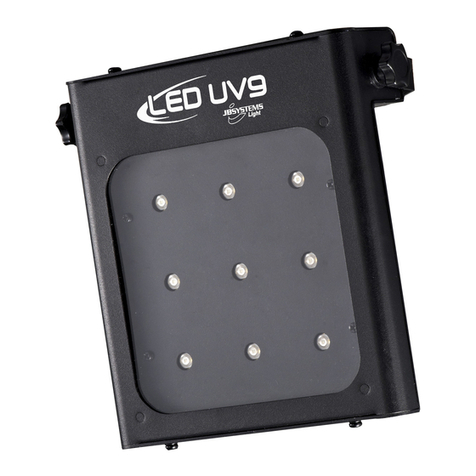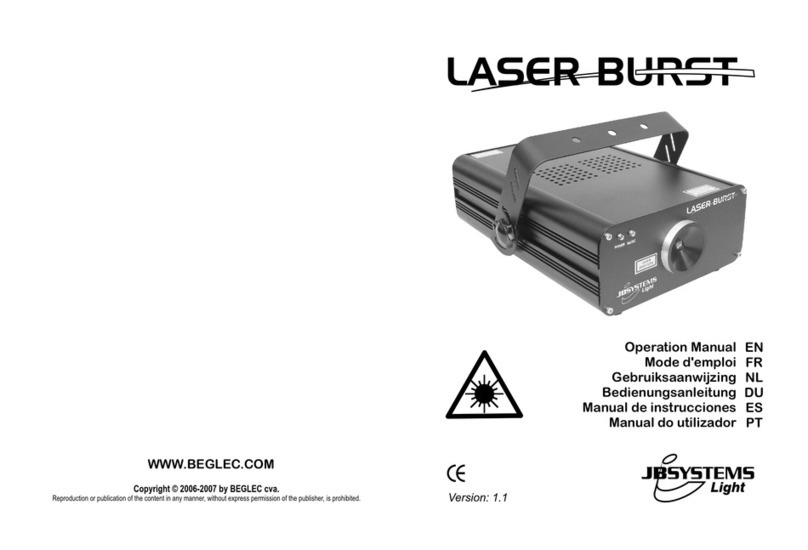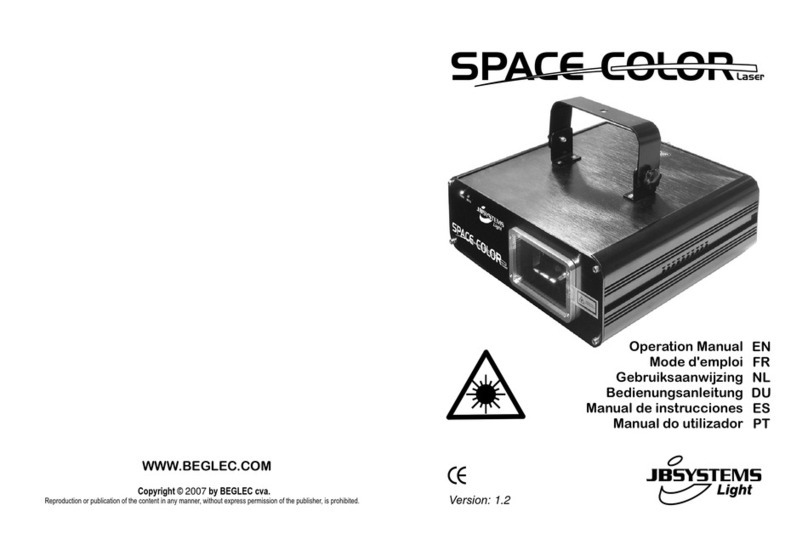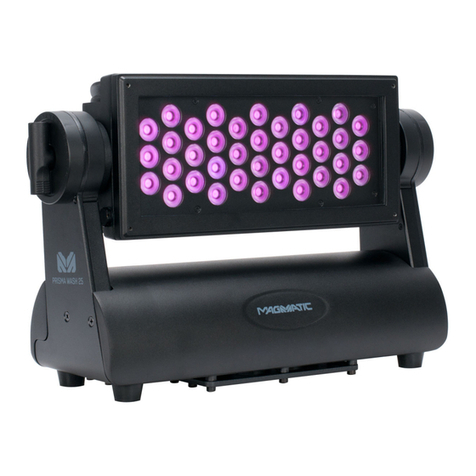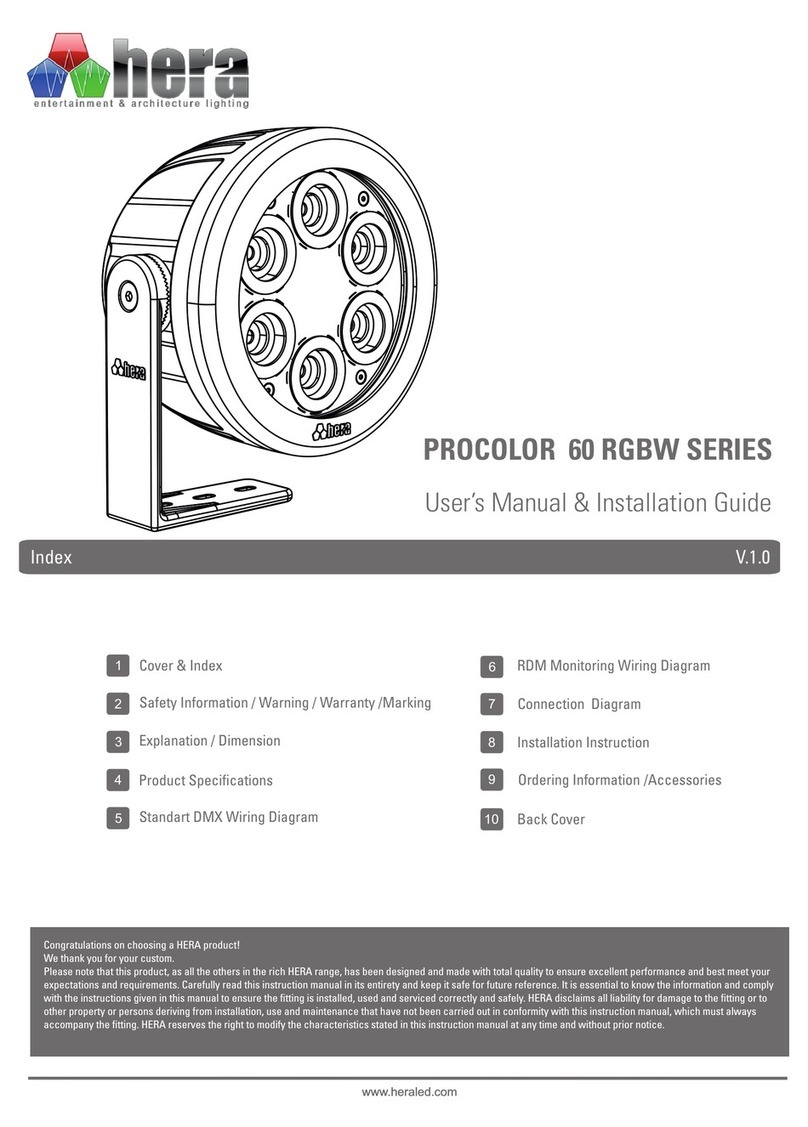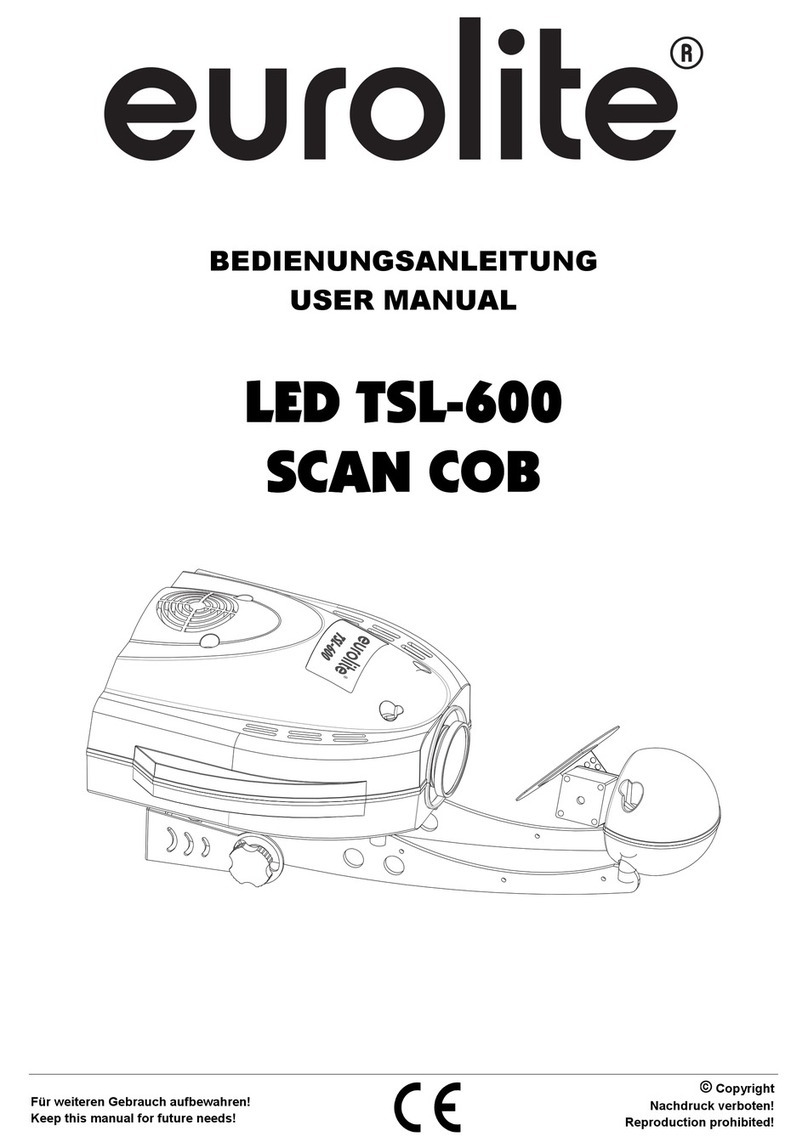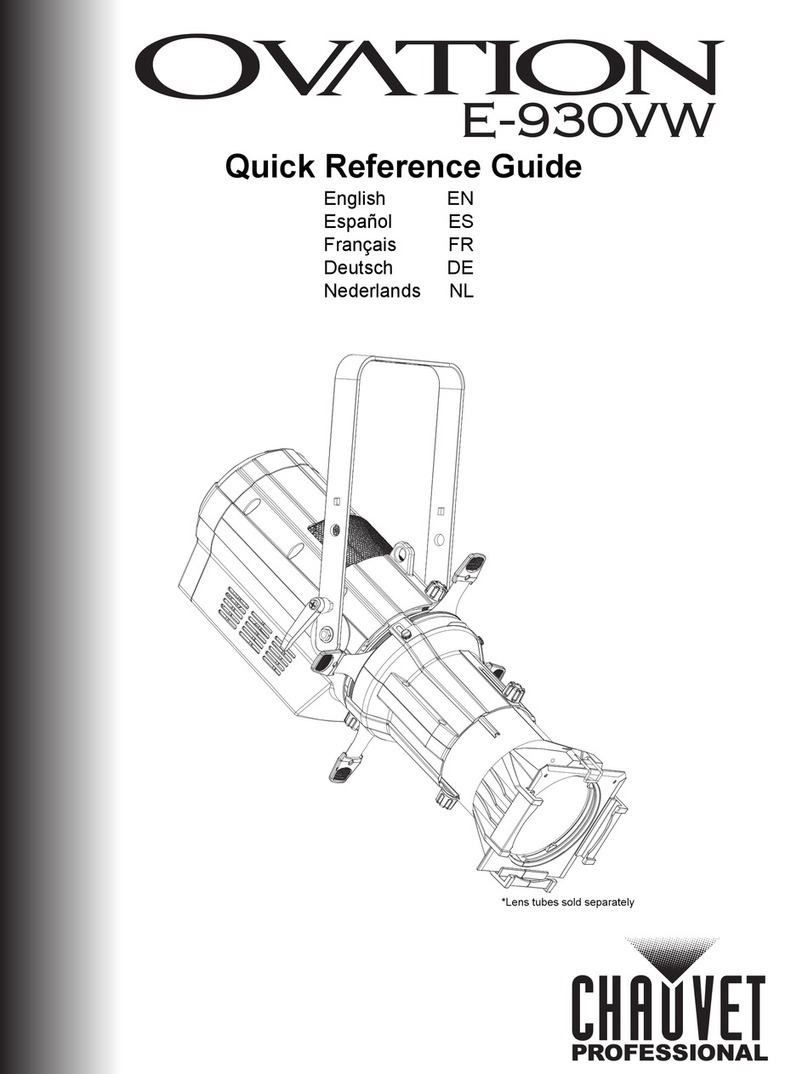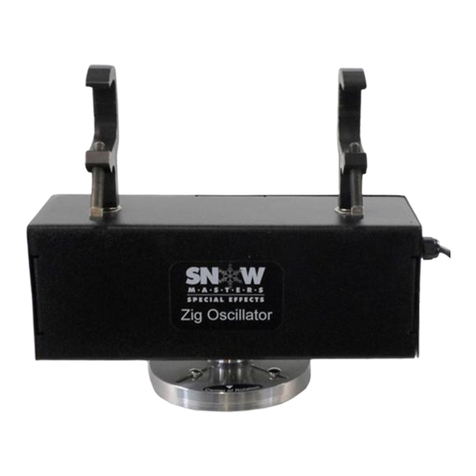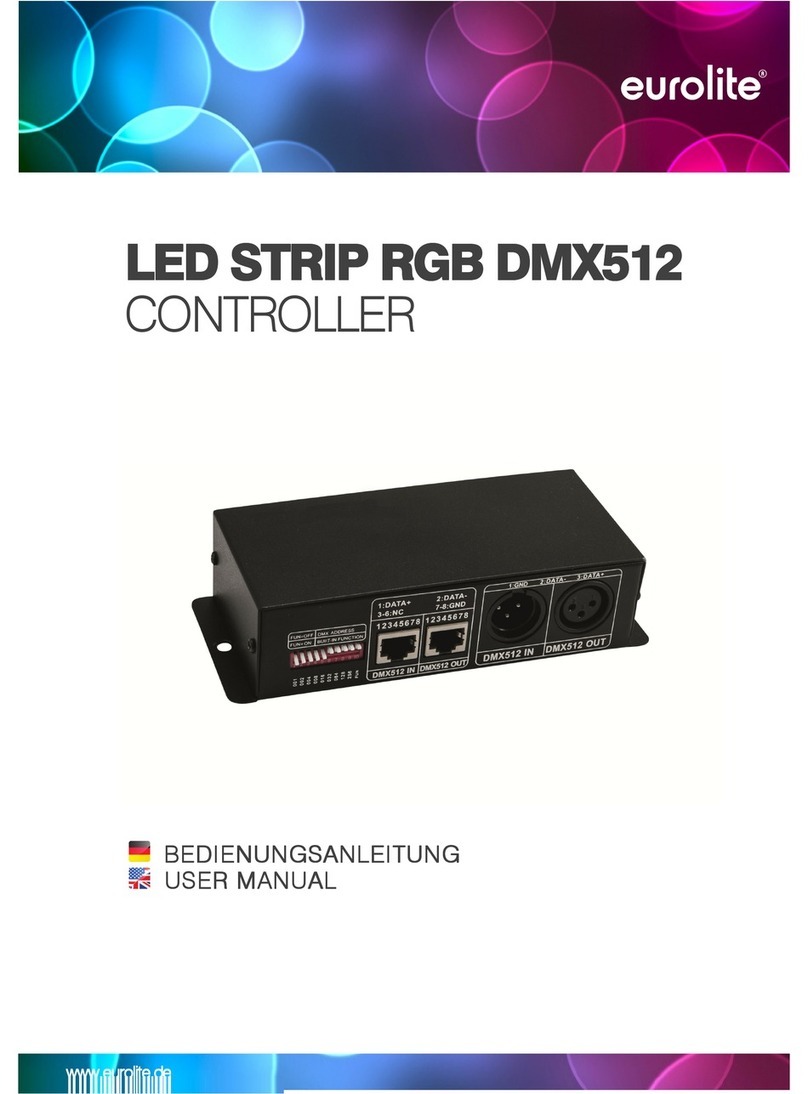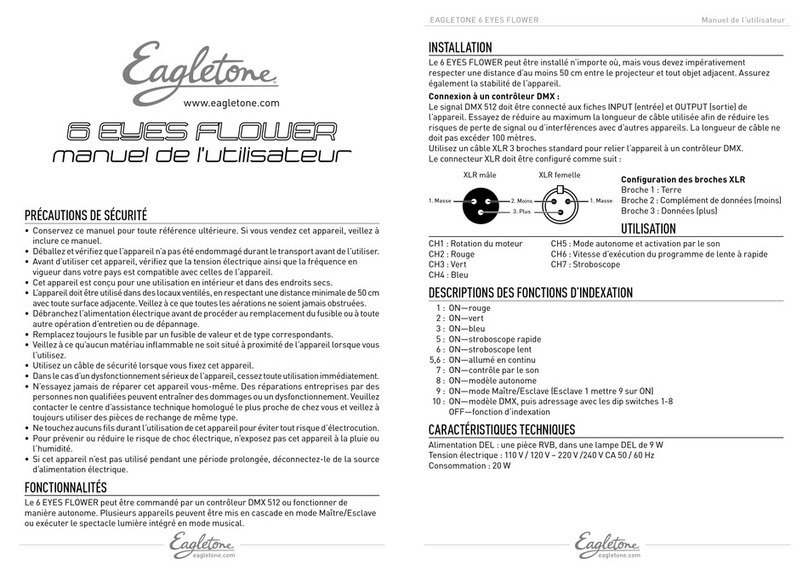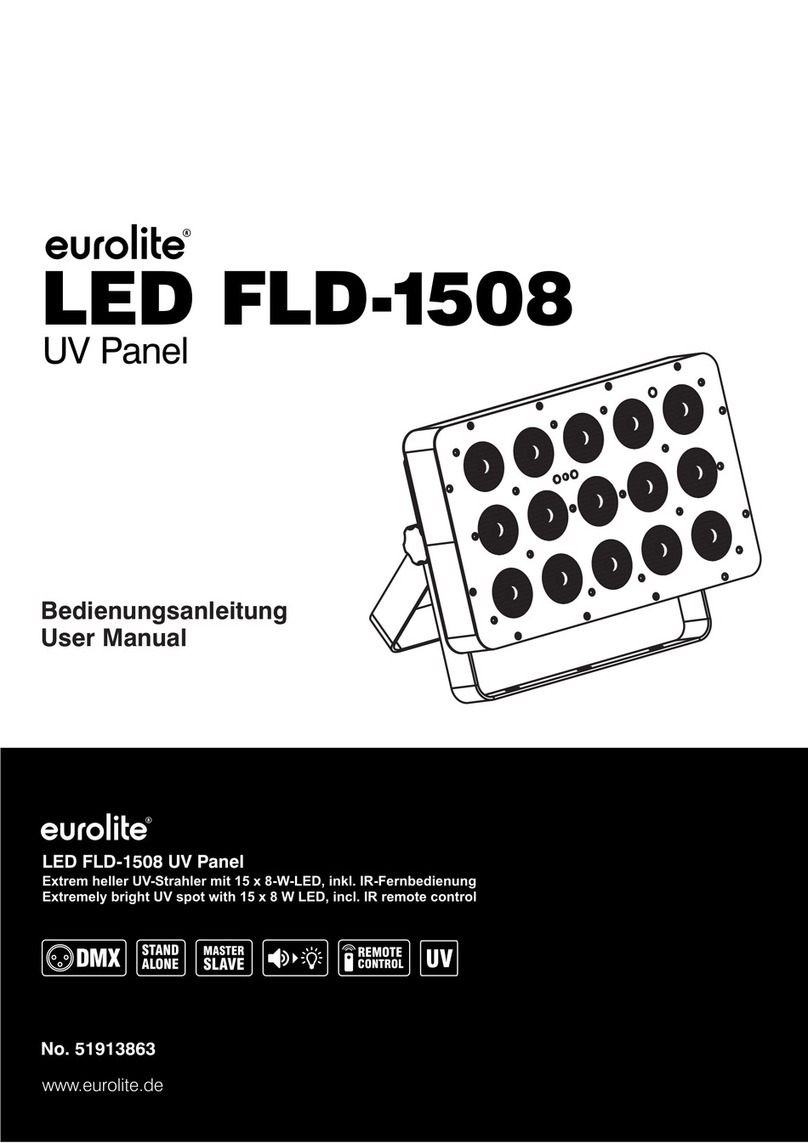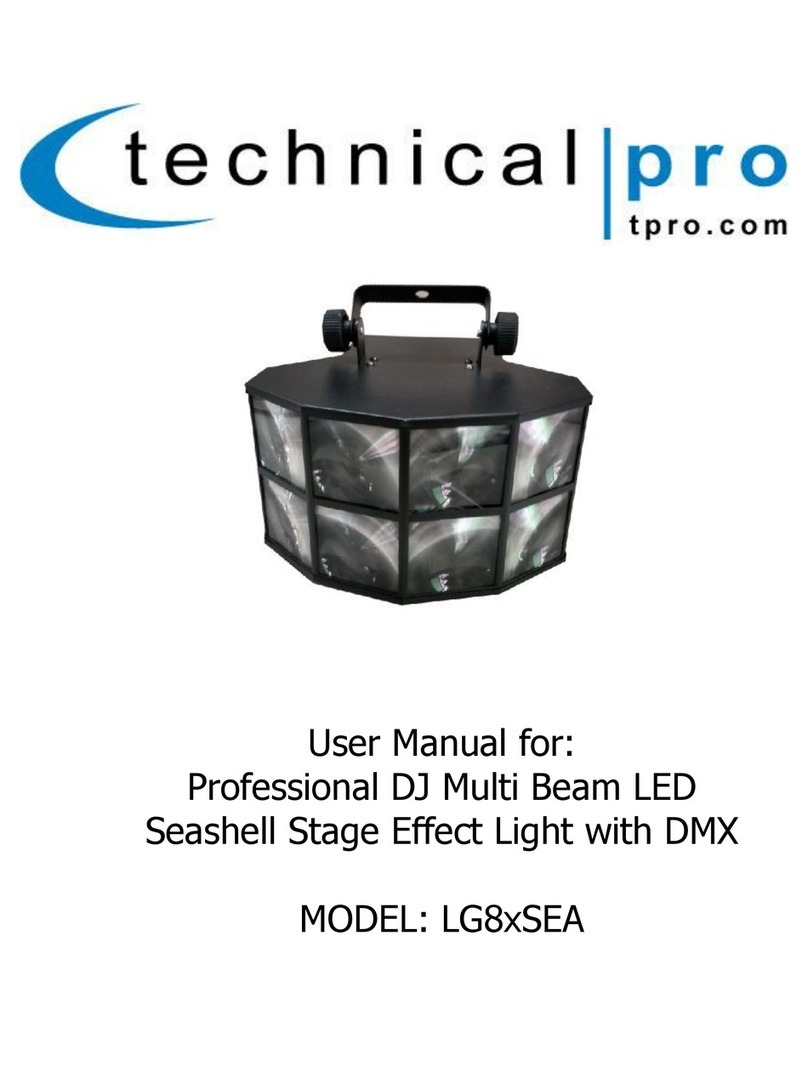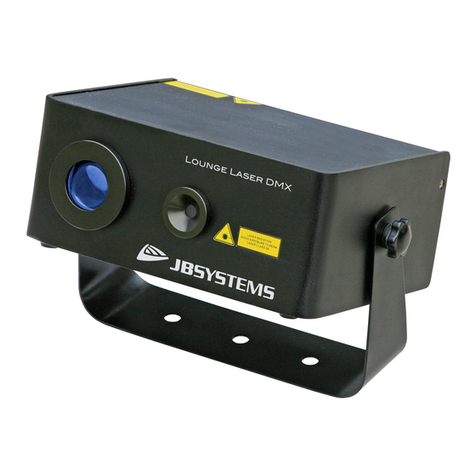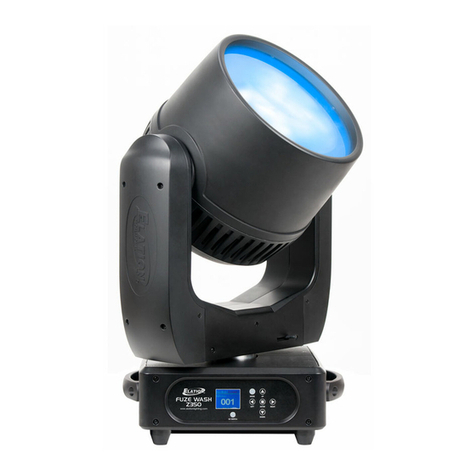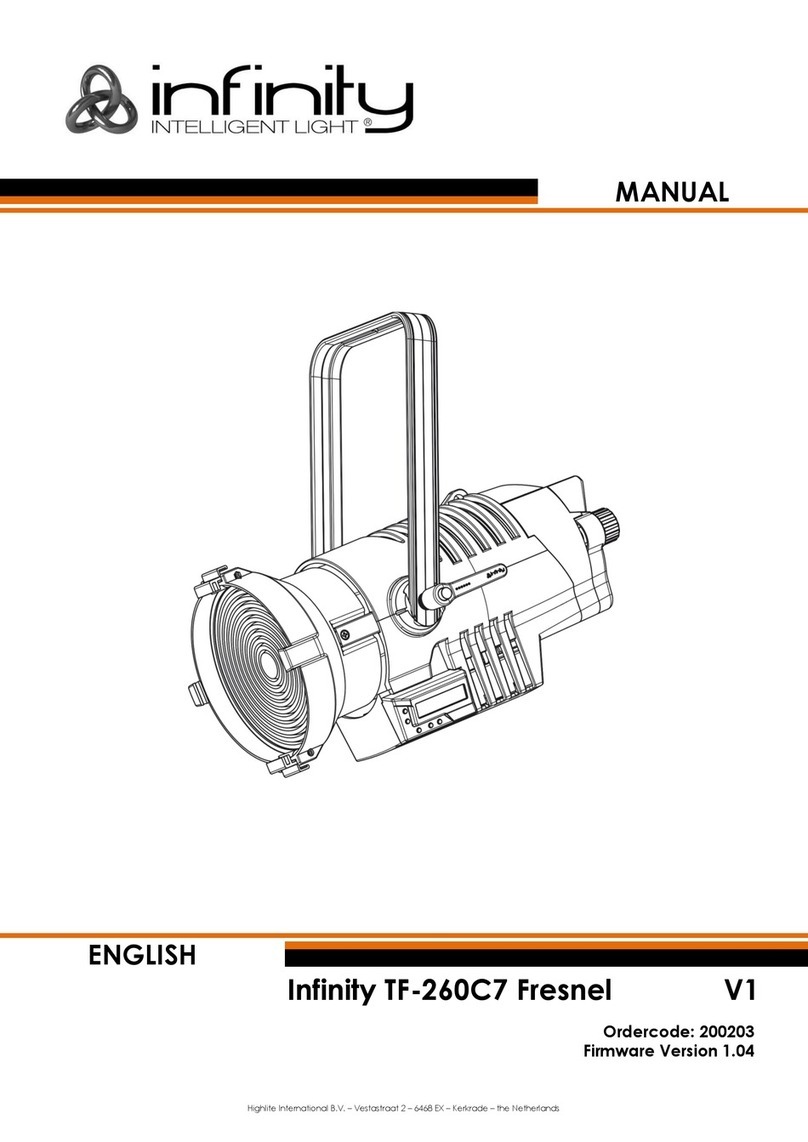
ENGLISH USER MANUAL
JB SYSTEMS® 5/78 TMC200
DELETE 4 HOT CUES: press the DELETE CUE button for about 2seconds to erase all 4 hot cues
from track memory.
DELETE TRACK: press the DELETE CUE button and MEMORY button (10) together for about
2seconds to delete the hot cues for the entire track from permanent memory. Because there will be
no way back, the display first asks you if you're sure: using the PITCH BEND buttons (21) you can
choose YES or NO.
Please refer to the chapter “HOW TO USE” for more information.
12. OPEN/CLOSE button: press this button to open and close the disc tray in the front of the TMC200. This
button is disabled during playback. If the tray is not closed after 60sec. It will close automatically to
prevent damage.
13. CD TRAY INDICATOR: is lit when a CD is loaded.
14. EFFECT buttons: each of these buttons has its own settings, described below:
ECHO EFFECT button: press this button to activate the echo effect. Depending on the sync-mode
(manual or beat synchronized), different settings are possible:
Manual mode: the BPM-SYNC button (17) is dark. You can set all parameters manually, use the
following controls:
Jog-wheel (27): used to set the echo time from 1ms to 2000ms.
IMPACT button (16): as long as the IMPACT-button is lit you can use the jog-wheel (27) to
change the impact (dry/wet) of the effect.
Beat synchronized mode: the BPM-SYNC button (17) is lit. You can use the following controls:
EFFECT SYNC-buttons (15+16): choose one of the beat synchronized echo presets.
IMPACT button (16): as long as the IMPACT-button is lit you can use the jog-wheel (27) to
change the impact (dry/wet) of the effect signal.
FLANGER EFFECT button: press this button to activate the flanger effect. Depending on the sync-
mode (manual or beat synchronized), different settings are possible:
Manual mode: the BPM-SYNC button (17) is dark. You can set all parameters manually, use the
following controls:
Jog-wheel (27): used to manually change the effect.
IMPACT button (16): as long as the IMPACT-button is lit you can use the jog-wheel (27) to
change the impact (dry/wet) of the effect.
Beat synchronized mode: the BPM-SYNC button (17) is lit. You can use the following controls:
EFFECT SYNC-buttons (15+16): choose one of the beat synchronized sweep presets.
IMPACT button (16): as long as the IMPACT-button is lit you can use the jog-wheel (27) to
change the impact (dry/wet) of the effect signal.
FILTER EFFECT button: press this button to activate the filter effect. Depending on the sync-mode
(manual or beat synchronized), different settings are possible:
Manual mode: the BPM-SYNC button (17) is dark. You can set all parameters manually, use the
following controls:
Jog-wheel (27): used to manually change the cutoff frequency of the filter.
IMPACT button (16): as long as the IMPACT-button is lit you can use the jog-wheel (27) to
change the impact (Q-factor) of the filter.
Beat synchronized mode: the BPM-SYNC button (17) is lit. You can use the following controls:
EFFECT SYNC-buttons (15+16): choose one of the beat synchronized sweep presets.
IMPACT button (16): as long as the IMPACT-button is lit you can use the jog-wheel (27) to
change the impact (Q-factor) of the filter.
BRAKE button: press this button to activate the brake effect. Now you can determine the
acceleration/deceleration speed of the music while using the PLAY/PAUSE button (8). You can set the
parameters with buttons (15+16), see below.
15. EFFECT SYNC/START-button: this button has several functions, depending on the effect mode:
BPM-Synced effects: when an effect is used in beat synchronized mode, this button is lit. You
can now choose how you want the effect to be synchronized to the beat. Use this button to cut
the current BPM-parameter in half.
BRAKE effect: press this button to change the acceleration time (time from zero to full speed).
While the button is lit, you can use the jog-wheel (27) to change the time from 0,0s (instant start)
to almost 10s. (very slow start)
16. EFFECT SYNC/STOP/IMPACT-button: this button has several functions, depending on the effect
mode:
BPM-Synced effects: when an effect is used in beat synchronized mode, this button is lit. You
can now choose how you want the effect to be synchronized to the beat. Use this button to
double the current BPM-parameter.
ENGLISH USER MANUAL
JB SYSTEMS® 6/78 TMC200
BRAKE effect: press this button to change the deceleration time (time from full speed to zero).
While the button is lit, you can use the jog-wheel (27) to change the time from 0,0s (instant stop)
to almost 10s. (very slow stop)
IMPACT parameter: while one of the 3 DSP-effects is activated, press the button until it starts
blinking. Now you can adapt the impact of the selected effect, also see EFFECT buttons (14).
17. BPM-SYNC button: press this button to toggle between manual and beat synchronized effect mode!
Please refer to point (14) for more information.
18. PITCH RANGE Button: Every time you press this button, you will change the scale of the speed
slider(20). On normal audio CDs you can select +/-4%, +/-8%, +/-16% and +/-100%. The +/-100% option
is not available on MP3 CDs.
19. SPEED Button: This button is used to turn the speed function on and off.
20. SPEED slider: Press the SPEED button(19), so it is lit. The speed can be changed up to +/-100% by
moving the fader. The speed will not change if the SPEED button(19) is off. You can change the pitch
range with the PITCH RANGE button(18)
21. PITCH BEND buttons: The speed rises while the “+ button” is pressed and returns to the original pitch
when the button is released. The speed drops when the “– button” is pressed and returns to the original
pitch when the button is released. These buttons can be used to synchronize the beats of 2 tracks. They
are also used to confirm (or not) the questions that are sometimes shown on the display.
22. PITCH LOCK Button: (Master tempo) activates the Pitch Lock function. This function allows you to
make adjustments to a tracks speed using the pitch control without altering its tonal pitch. This button
turns blue when the Pitch Lock is on.
NOTE: be informed that the pitch lock function has its limitations. From a certain speed deviation
(depends on the music style) the pitch lock won’t be able to keep the same pitch anymore. First you will
hear a small distortion that becomes more important at higher speed deviations. This is not always a
disadvantage: at very low speeds you can also use it as a special “distortion effect”!
23. TIME Button: The TIME button switches between elapsed playing time, remaining time in a selection
and total remaining time of the disc. (standard = remaining /track) The “total remaining time of the disc”
is not available on MP3 CDs.
24. SGL/CTN Button: with this button you can choose between “single track mode” and “continuous play”.
You can also switch the auto cue function (-48dB) on and off.
Continuous play: the complete CD will be played without interruption. (mostly used in pubs)
Single track: player stops at the end of each track and waits at the beginning of the next track.
The player waits at the first music note of each track. This means that badly indexed CDs will not
interfere with the instant start capabilities of this CD player. This is a very useful feature for
deejays!
Auto Cue on/off: The TMC200 automatically detects the first “music note” on each track to
ensure the music starts immediately when you press the play button. To turn this Auto Cue
function on/off just press the SGL/CTN button for about 2 seconds. The display shows “A.CUE”
when the function is active.
25. BPM-TAP button: This player has a full automatic BPM-counter. In some rare cases the automatic beat
counter doesn’t count as it should do (beats are out of the normal range or there’s simply no beat to
detect). In these cases you can help the beat counter by manually tapping this button to the rhythm of
the beat. You can switch back to the automatic beat counter by pressing the TAP button until the
“AUTOBPM” in the left upper corner of the display turns on.
26. ID3-TAGS Button: to make things easier for you most MP3-tracks contain ID3-tags to give you more
information about the selected song. The TMC200 can show some of these tags on the display:
“Song title” information: by default the display shows the “song title”.
“Artist” information: press the ID3-TAGS-button 1x to show the artist name, the display returns
automatically to default.
“Bit-rate” information: press the ID3-TAGS-button 2x to show the bit-rate (recording quality) of
the track, the display returns automatically to default.
When the track doesn’t have ID3-tags, the display shows the file name (xxxxxxxxx.mp3)
27. TACTILE JOG-WHEEL: This jog wheel serves different functions depending on the working mode:
The jog wheel acts as a slow frame search (1/75sec) control when the CD is not playing but either
paused or set to a cue point. To set a new cue point, spin the wheel then press PLAY(8) or LOOP
IN(4) when you have determined the proper position. Press CUE(7) to return to the “CUE POINT”.
If the track is playing, the jog wheel temporarily bends the pitch of the music up to +/-100% by rotating
the wheel clockwise to speed it up or counterclockwise to slow it down. The amount of pitch change is
determined by the speed of rotation. This is an alternative to the PITCH BEND buttons(21).
